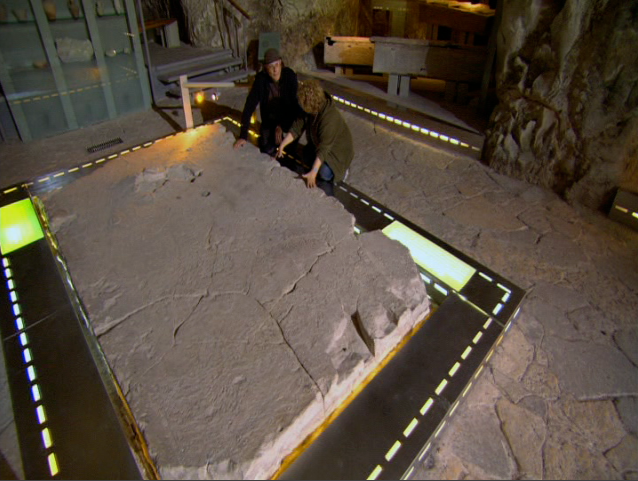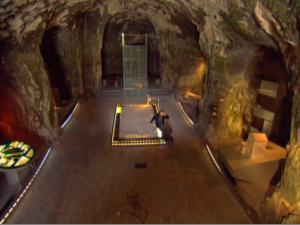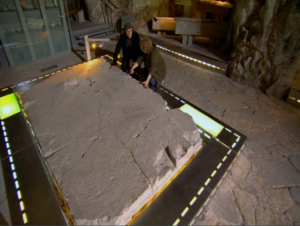Temple Glass Discovered?!
Not many people realize this but the biggest slab of raw glass from the ancient world was discovered in northern Israel in “Beit She’arim”, in the Galilee, in 1956. The rectangular glass slab is 11×6.5×1.5 feet, weighing 9 tons. Beit She’arim is a cemetery where the editor of the Mishna (the first “layer” of the Talmud), Rabbi Judah the Prince/Yehudah haNasi (135 to 217 CE) is buried. Most people visiting this cemetery are not aware that the chunk of glass is there, looking somewhat opaque on the floor of the cave that serves as the visitors’ center.
Common wisdom has it that the giant slab is part of a failed business venture of the 4th century. According to this theory, someone started a glass factory in the middle of the cemetery and when some plant ash fell into the glass, making it opaque, the business venture was abandoned and so was the glass. Does this make any sense? Who would start a glass factory in the middle of a centuries old cemetery? But what if it’s the other way around? What if the glass was special and the people buried in the cemetery came far and wide to be buried next to it?
Because glass today is so all pervasive, people don’t realize that it had to be invented. Unlike basket weaving, however, it was invented – only once! According to the Roman historian Tacitus, this magical event happened in Israel. No one has ever explained how that might have occurred. After all, glass requires sand, natron (a mineral from dry lake beds) and a pyrotechnology that is very, very sophisticated. You need to have ovens that can sustain 1500°C over long periods of time. Who would ever mix sand and lake salt and throw them for days on end into a blazing fire? It’s a mystery.
According to modern scholars, glass was first invented in Egypt 3,000 years ago. From there, it made its way to the Phoenicians of modern Lebanon and from there it proliferated to the world. According to this theory, glass was perfected by the Romans in the 1st century. But according to the late researcher, Samuel Kurinsky, glass originated 3,800 years ago in Ur – Abraham’s hometown, in modern Iraq. From there, it basically followed the footsteps of the Jewish people. Glass went to Canaan, then to Egypt, back to Canaan and from there across the world. The link between the Jewish people and glassmaking can be seen in something as simple as the many glass related names that Jews have today e.g., Glasser, Glassman, Glasserson etc. But it’s more than that. The biggest glass factory of the ancient world was found in Beit Eliezer on the coast of Israel, modern Hadera – 17 furnaces! Glass was a seasonal occupation. You needed strong autumn winds to blow through the furnaces and maintain the high temperatures. Molded glass was replaced by blown glass in the 1st century. The oldest blown glass ever found was also discovered in Israel – in the Jewish quarter of Jerusalem.
Again, no one realizes this, but to reiterate; the biggest piece of glass, the largest factory and the oldest blown glass in the world were all found in Israel. Why were Jews so interested in glass? First of all, it was a secret recipe guarded for millennia with more care than the recipe for Coca Cola. Second of all, according to Jewish law, glass does not absorb “tuma” i.e., impurity. If a piece of pork makes contact with ceramic – you’ve invalidated the plate and have to destroy it. But if glass comes into contact with the ham, wash the plate and you’re good to go. So the Jewish people have a religious reason to desire glass. Which brings us back to the biggest slab sitting in the Galilee to this day. What’s it doing there?
In 1 Kings 6:4 it says that when he built the first Temple of God in Jerusalem in the 10th century BCE, King Solomon built windows that were – in Hebrew – “shkufim and atumim”. This is usually translated as “narrow” but, more correctly, it means; “transparent and of one piece”. The Temple in Jerusalem was a repository of technology that was way ahead of its time. Can it be that the Bible is describing giant glass windows made of one piece? In the 1st century, King Herod the Great renovated the second Temple, making it one of the wonders of the world. Can it be that he outfitted his new temple with the greatest slabs of glass that had ever been made? Herod’s Temple was destroyed by the Romans in 70 CE. The Jews were dispersed throughout the world, bringing their glass making with them to places like Rome and Venice. In the Galilee, it seems, one window that had been contaminated with ash, was left where it was created. For those who wanted to be buried close to a relic of the Holy Temple, that glass was as close as you could get.
What all this means is that there was no glass factory built in a cemetery in the Galilee. What probably happened was that holy people such as Judah the editor of the Talmud wanted to be buried next to the glass. What this also means is that a neglected piece of the Jerusalem Temple – the House of God – is still right there in a Galilean cave.
See also: http://www.cmog.org/article/mystery-slab-beth-shearim
Watch a short video about the Temple glass discovered here:



